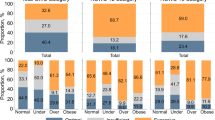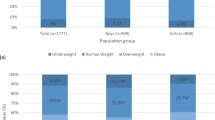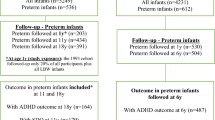Abstract
While it is known that intrauterine growth restriction is associated with later mental disorders, it is still unclear whether similar associations exists for postnatal weight faltering, also known as ‘failure to thrive’ in infancy. This study examined the potential connection between infancy weight faltering and mental disorders diagnosed in childhood focusing specifically on neurodevelopmental disorders. The Copenhagen Child Cohort (CCC2000) was used to explore weight gain in infancy assessed by community health nurses. Data from the Danish national registries were used to quantify ICD-10 mental disorders diagnosed between birth and 12 years of age, as well as potential child and family confounders. Of 4.476 children with sufficient weight data, 339 (7.3%) children were diagnosed with a mental disorder in childhood. Both any (weight gain < -1SD) and severe infancy weight faltering (weight gain < -2SD) were associated with psychomotor delays, while severe infancy weight faltering was also associated with intellectual impairments. Notably, no significant associations were found between weight faltering and autism spectrum disorders or attention deficit hyperactivity disorders. Weight faltering in infancy may be an early marker of neurodevelopmental delays. This possibility should be considered when assessing infants with slow weight gain, to early identification and treatment of co-occurring neurodevelopmental disorders.
Similar content being viewed by others
References
Alkandari F, Ellahi A, Aucott L, Devereux G, Turner S (2015) Fetal ultrasound measurements and associations with postnatal outcomes in infancy and childhood: a systematic review of an emerging literature. J Epidemiol Community Health 69(1):41–48. https://doi.org/10.1136/jech-2014-204091 (Epub 2014 Sep 4 PMID: 25190820)
Lemcke S, Parner ET, Bjerrum M, Thomsen PH, Lauritsen MB (2016) Early development in children that are later diagnosed with disorders of attention and activity: a longitudinal study in the Danish National Birth Cohort. Eur Child Adolesc Psychiatry 25(10):1055–1066. https://doi.org/10.1007/s00787-016-0825-6 (Epub 2016 Feb 9 PMID: 26861952)
Lemcke S, Parner ET, Bjerrum M, Thomsen PH, Lauritsen MB (2018) Early regulation in children who are later diagnosed with autism spectrum disorder. A longitudinal study within the Danish National Birth Cohort. Infant Ment Health J 39(2):170–182. https://doi.org/10.1002/imhj.21701 (Epub 2018 Feb 27. PMID: 29485729)
Class QA, Rickert ME, Larsson H, Lichtenstein P, D’Onofrio BM (2014) Fetal growth and psychiatric and socioeconomic problems: population-based sibling comparison. Br J Psychiatry 205(5):355–361. https://doi.org/10.1192/bjp.bp.113.143693
Allen MC (2008) Neurodevelopmental outcomes of preterm infants. Curr Opin Neurol 21(2):123–128. https://doi.org/10.1097/WCO.0b013e3282f88bb4 (PMID: 18317268)
Thapar A, Rutter M (2018) Neurodevelopmental disorders. In: Thapar A, Pine D, Leckman JF, Scott S, Snowling MJ, Taylor E (eds) Rutter’s child and adolescent psychiatry. Wiley, Oxford, pp 31–40
Thapar A, Cooper M, Rutter M (2017) Neurodevelopmental disorders. Lancet Psychiatry 4(4):339–346. https://doi.org/10.1016/S2215-0366(16)30376-5 (Epub 2016 Dec 13 PMID: 27979720)
Abel KM, Wicks S, Susser ES, Dalman C, Pedersen MG, Mortensen PB, Webb RT (2010) Birth weight, schizophrenia, and adult mental disorder: is risk confined to the smallest babies? Arch Gen Psychiatry 67(9):923–930. https://doi.org/10.1001/archgenpsychiatry.2010.100 (PMID: 20819986)
Faa G, Manchia M, Pintus R, Gerosa C, Marcialis MA, Fanos V (2016) Fetal programming of neuropsychiatric disorders. Birth Defects Res C Embryo Today 108(3):207–223. https://doi.org/10.1002/bdrc.21139 (Epub 2016 Oct 24 PMID: 27774781)
Mullins N, Lewis CM (2017) Genetics of depression: progress at last. Curr Psychiatry Rep 19:43. https://doi.org/10.1007/s11920-017-0803-9
Fisher D, Baird J, Payne L, Lucas P, Kleijnen J, Roberts H, Law C (2006) Are infant size and growth related to burden of disease in adulthood? A systematic review of literature. Int J Epidemiol 35(5):1196–1210. https://doi.org/10.1093/ije/dyl130 (Epub 2006 Jul 15 PMID: 16845132)
Corbett SS, Drewett RF (2004) To what extent is failure to thrive in infancy associated with poorer cognitive development? A review and meta-analysis. J Child Psychol Psychiatry 45(3):641–654. https://doi.org/10.1111/j.1469-7610.2004.00253.x (PMID: 15055382)
Olsen EM, Skovgaard AM, Weile B, Petersen J, Jørgensen T (2010) Risk factors for weight faltering in infancy according to age at onset. Paediatr Perinat Epidemiol 24(4):370–382. https://doi.org/10.1111/j.1365-3016.2010.01118.x (PMID: 20618727)
Borowitz KC, Borowitz SM (2018) Feeding problems in infants and children: assessment and etiology. Pediatr Clin North Am 65(1):59–72. https://doi.org/10.1016/j.pcl.2017.08.021 (PMID: 29173720)
Elberling H, Linneberg A, Olsen EM, Houmann T, Rask CU, Goodman R, Skovgaard AM (2014) Infancy predictors of hyperkinetic and pervasive developmental disorders at ages 5–7 years: results from the Copenhagen Child Cohort CCC2000. J Child Psychol Psychiatry 55(12):1328–1335. https://doi.org/10.1111/jcpp.12256 (Epub 2014 May 30 PMID: 24889385)
Emond A, Drewett R, Blair P, Emmett P (2007) Postnatal factors associated with failure to thrive in term infants in the Avon Longitudinal Study of parents and children. Arch Dis Child 92(2):115–119. https://doi.org/10.1136/adc.2005.091496 (Epub 2006 Aug 11. PMID: 16905563; PMCID: PMC2083322)
Holme AR, Blair PS, Emond AM (2013) Psychosocial and educational outcomes of weight faltering in infancy in ALSPAC. BMJ Open 3(7):e002863. https://doi.org/10.1136/bmjopen-2013-002863 (PMID:23833121;PMCID:PMC3703578)
Rutter M (2009) Understanding and testing risk mechanisms for mental disorders. J Child Psychol Psychiatry 50(1–2):44–52. https://doi.org/10.1111/j.1469-7610.2008.01976.x (PMID: 19220588)
Pereira PK et al (2012) Maternal mental disorders in pregnancy and the puerperium and risks to infant health. World J Clin Pediatrics 1(4):20–23. https://doi.org/10.5409/wjcp.v1.i4.20
Barker DJ, Osmond C, Rodin I, Fall CH, Winter PD (1995) Low weight gain in infancy and suicide in adult life. BMJ 311(7014):1203. https://doi.org/10.1136/bmj.311.7014.1203
Skovgaard AM, Olsen EM, Houmann T, Christiansen E, Samberg V, Lichtenberg A, Jørgensen T (2005) The Copenhagen County child cohort: design of a longitudinal study of child mental health. Scand J Public Health 33(3):197–202. https://doi.org/10.1080/14034940510005662 (PMID: 16040460)
Olsen EM, Rask CU, Elberling H et al (2020) Cohort profile: the Copenhagen Child Cohort Study (CCC2000). Int J Epidemiol 49(2):370–371l
de Onis M and WHO Multicentre Growth Reference Study Group (2006) WHO Child Growth Standards - Total report: Length/height-for-age. Weight-for-age. Weight-for-length. Weight-for-height and body mass index-for-age: Methods and development. Geneva: World Health Organization. ISBN: 924154693X
Wright CM, Matthews JN, Waterston A, Aynsley-Green A (1994) What is a normal rate of weight gain in infancy? Acta Paediatr 83(4):351–356. https://doi.org/10.1111/j.1651-2227.1994.tb18118.x (PMID: 8025388)
Olsen EM, Petersen J, Skovgaard AM, Weile B, Jørgensen T, Wright CM (2007) Failure to thrive: the prevalence and concurrence of anthropometric criteria in a general infant population. Arch Dis Child 92(2):109–114. https://doi.org/10.1136/adc.2005.080333 (Epub 2006 Mar 10. PMID: 16531456; PMCID: PMC2083342)
World Health Organization (1992) The ICD-10 classification of mental and behavioral disorders: clinical descriptions and diagnostic guidelines. Geneva: World Health Organization
Thygesen LC, Daasnes C, Thaulow I, Brønnum-Hansen H (2011) Introduction to Danish (nationwide) registers on health and social issues: structure, access, legislation, and archiving. Scand J Public Health 39(7 Suppl):12–16. https://doi.org/10.1177/140349481139995
Benjamini Y, Hochberg Y (1995) Controlling the false discovery rate—a practical and powerful approach to multiple testing. J R Stat Soc Ser B Methodol 57:289–300
Aarnoudse-Moens CS, Weisglas-Kuperus N, van Goudoever JB, Oosterlaan J (2009) Meta-analysis of neurobehavioral outcomes in very preterm and/or very low birth weight children. Pediatrics 124(2):717–728. https://doi.org/10.1542/peds.2008-2816 (Epub 2009 Jul 27 PMID: 19651588)
National Institute for Health and Care Excellence (2017) Faltering growth: recognition and management of faltering growth in children NICE guideline NG75. Published: 27 September 2017
Reilly SM, Skuse DH, Wolke D, Stevenson J (1999) Oral-motor dysfunction in children who fail to thrive: organic or non-organic? Dev Med Child Neurol 41(2):115–122. https://doi.org/10.1017/s0012162299000225 (PMID: 10075097)
Wilensky DS, Ginsberg G, Altman M, Tulchinsky TH, Ben Yishay F, Auerbach J (1996) A community based study of failure to thrive in Israel. Arch Dis Child 75(2):145–148. https://doi.org/10.1136/adc.75.2.145 (PMID:8869197;PMCID:PMC1511632)
Koch SV, Andersson M, Hvelplund C, Skovgaard AM (2020) Mental disorders in referred 0–3-year-old children: a population-based study of incidence, comorbidity and perinatal risk factors. Eur Child Adolesc Psychiatry. https://doi.org/10.1007/s00787-020-01616-2 (Epub ahead of print. PMID: 32815033)
American Psychiatric Association (2013) Diagnostic and statistical manual of mental disorders (DSM-5). American Psychiatric Association, Washington
World Health Organization (2018) International classification of diseases for mortality and morbidity statistics (11th Revision). Version : 05/2021
Becker KR, Keshishian AC, Liebman RE, Coniglio KA, Wang SB, Franko DL, Eddy KT, Thomas JJ (2019) Impact of expanded diagnostic criteria for avoidant/restrictive food intake disorder on clinical comparisons with anorexia nervosa. Int J Eat Disord 52(3):230–238. https://doi.org/10.1002/eat.22988 (Epub 2018 Dec 22)
Nicely TA, Lane-Loney S, Masciulli E, Hollenbeak CS, Ornstein RM (2014) Prevalence and characteristics of avoidant/restrictive food intake disorder in a cohort of young patients in day treatment for eating disorders. J Eat Disord 2(1):21. https://doi.org/10.1186/s40337-014-0021-3.PMID:25165558;PMCID:PMC4145233
Lynge E, Sandegaard JL, Rebolj M (2011) The Danish national patient register. Scand J Public Health 39(7 Suppl):30–33. https://doi.org/10.1177/1403494811401482 (PMID: 21775347)
Dalsgaard S, Thorsteinsson E, Trabjerg BB, Schullehner J, Plana-Ripoll O, Brikell I, Wimberley T, Thygesen M, Madsen KB, Timmerman A, Schendel D, McGrath JJ, Mortensen PB, Pedersen CB (2020) Incidence rates and cumulative incidences of the full spectrum of diagnosed mental disorders in childhood and adolescence. JAMA Psychiat 77(2):155–164. https://doi.org/10.1001/jamapsychiatry.2019.3523 (PMID:31746968;PMCID:PMC6902162)
Lauritsen MB, Jørgensen M, Madsen KM, Lemcke S, Toft S, Grove J, Schendel DE, Thorsen P (2010) Validity of childhood autism in the Danish Psychiatric Central Register: findings from a cohort sample born 1990–1999. J Autism Dev Disord 40(2):139–148. https://doi.org/10.1007/s10803-009-0818-0 (Epub 2016 Apr 7. PMID: 27061373)
Mohr-Jensen C, Vinkel Koch S, Briciet Lauritsen M, Steinhausen HC (2016) The validity and reliability of the diagnosis of hyperkinetic disorders in the Danish Psychiatric Central Research Registry. Eur Psychiatry 35:16–24. https://doi.org/10.1016/j.eurpsy.2016.01.2427 (Epub 2016 Apr 7. PMID: 27061373)
Acknowledgements
The study was financially supported by Mrs. C. Hermansen's memorial Foundation, Dagmar Marshall's Foundation, Lundbeck Foundation, and Tryg Foundation.
Author information
Authors and Affiliations
Contributions
EMO conceived the original ideas for the study, designed the design of the specific investigation, and conducted the analyses, and was primarily responsible for writing the manuscript. CMW critically reviewed the design and the manuscript for important intellectual content and commented upon the drafts of the manuscript. KFM critically reviewed the manuscript for important intellectual content and commented upon the drafts of the manuscript. KKN contributed with the data plan, and contributed to the writing and formatting manuscript and commented upon the drafts of the manuscript. AMS conceptualized the larger cohort study in which this study is nested, critically reviewed the design and the manuscript for important intellectual content, and commented upon the drafts of the manuscript.
Corresponding author
Ethics declarations
Conflict of interest
The funding foundations had no role in the design and conduct of the study.
Supplementary Information
Below is the link to the electronic supplementary material.
Rights and permissions
About this article
Cite this article
Olsen, E.M., Nilsson, K.K., Wright, C.M. et al. Infancy weight faltering and childhood neurodevelopmental disorders: a general population birth-cohort study. Eur Child Adolesc Psychiatry 32, 1179–1188 (2023). https://doi.org/10.1007/s00787-021-01915-2
Received:
Accepted:
Published:
Issue Date:
DOI: https://doi.org/10.1007/s00787-021-01915-2




